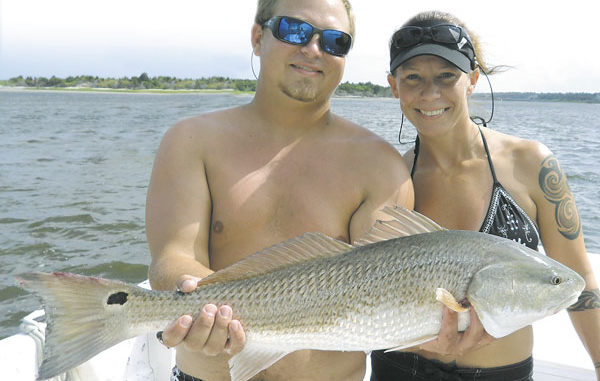
Carolina Beach is a favorite fishing destination for lots of North Carolina anglers.
Carolina Beach is a popular destination for many fishermen from across North Carolina, plus visitors from other states. The ease of access in past years built the popularity, which continues. Located near the end of US 421 and the southernmost of the Wilmington area beaches, Carolina Beach enjoyed easy access in the years before I-40 was built. Now, access is even easier, and the crowds, especially on weekends, bear this out.
Carolina Beach serves as the gateway for fishermen visiting “Pleasure Island,” arriving with boats in tow. US 421 crosses the Intracoastal Waterway at Snow’s Cut and provides access to the island, which Kure Beach and Fort Fisher also call home. The northern end is at Carolina Beach Inlet, but the southern end is not quite as definite. The southern end was Corncake Inlet until it filled in many years ago, and then New Inlet filled in during the 1990s, so it’s possible to walk all the way to Bald Head Island — vehicular traffic is forbidden beyond the southern end of the Fort Fisher State Recreation Area.
Carolina Beach is is one of the few southern beaches that still allows beach driving year-round. The northern end of Carolina Beach is an undeveloped area known as Freeman Park. Using this area requires a 4-wheel drive vehicle, and there is a fee, but fishermen and other beach-goers are allowed to drive up the beach to Carolina Beach Inlet. Daily permits can be purchased at the entrance, and seasonal permits are also available. For more information, visit www.pleasureislandnc.org.
At the southern end, the Fort Fisher State Recreation Area also allows beach driving on a 4-mile stretch of sand between the recreation area’s office and the former location of New Inlet — it’s open to vehicles and popular with surf fishermen. There is a fee for driving on the beach, and daily or annual permits can be purchased. For more information, visit www.ncparks.gov.
While there was construction through the winter and into the spring, the three public ramps on Pleasure Island are open: a wildlife ramp on the ICW at Snow’s Cut, a ramp on the ICW at Carolina Beach State Park and a wildlife ramp at the end of US 421 at Federal Point at Fort Fisher.
Capt. Dennis Barbour (910-470-5041, www.islandtacklehard-ware.com) and his son, Wes, operate Island Tackle Fishing Charters, a natural offshoot of the family business, Island Tackle and Hardware, in Carolina Beach. Barbour has had his charter license for 35 years, and 10 years ago, he followed his passion from the offshore ocean to inshore and nearshore waters and began to target flounder, red drum and speckled trout.
Barbour specializes in catching flounder, which have a reputation for being large and plentiful in the Carolina Beach area. In addition, he finds plenty of redfish, many of which are at the upper end and beyond the slot. Also connecting well with speckled trout, Virginia mullet (whiting, sea mullet) and sheepshead gives him a versatility that puts a high value on his interpretation of the fishing in the waters around Pleasure Island. Here are some of his favorite spots.
1. Hole in the Wall
N 33 56 06/W 077 57 31
“This wall stretches from Federal Point across The Basin, around Zeke’s Island and across Second Bay, separating them from the (Cape Fear) river,” Barbour said pointing to the line of rocks. “It was built as a structure to prevent water from running from Corncake Inlet directly to the river, but now as it is older and crumbling in places, water rushes across it in these places and carries a lot of bait back and forth. This is only one of several places where this happens, and there are usually some fish at every one.”
Barbour said a variety of fish gather on the downcurrent side of the wall to feed on each tide: trout, red drum, flounder, black drum, sheepshead and even some juvenile grouper at times. Barbour said near the top of the rising tide, the water and bait spill across from the river into the bays, and fish gather around the bayside of the breach. When the tide begins falling, the water runs the other way and carries baitfish back into the river, so the fish gather on the river side.
Barbour said the breaks and the wall itself are excellent places to fish, but he urges caution. On full-moon and other abnormally high tides, the water may completely cover the rocks, and seeing the current line is the only way to locate them. There is a short time right as the tide switches when the water isn’t moving and locating the rocks is extremely difficult, so being cautious is absolutely necessary.
Barbour said because the water is washing bait across the rocks, he prefers to fish with live bait. He likes to use peanut pogies and fishes some on the bottom on Carolina rigs and some suspended beneath the surface on rattling-cork rigs. In a mild winter, the Wall will hold fish year-round, but if the weather gets cold, the shallower water inside the Wall is often a little warmer and might hold fish year-round. The outside of the wall is definitely a late-spring to late-fall spot.
To read the rest of this article, which appears in the June issue of North Carolina Sportsman, download a digital issue or pick up a copy on your nearest newsstand.
Subscribe to the magazine to ensure you don’t miss a single issue of North Carolina.





Be the first to comment